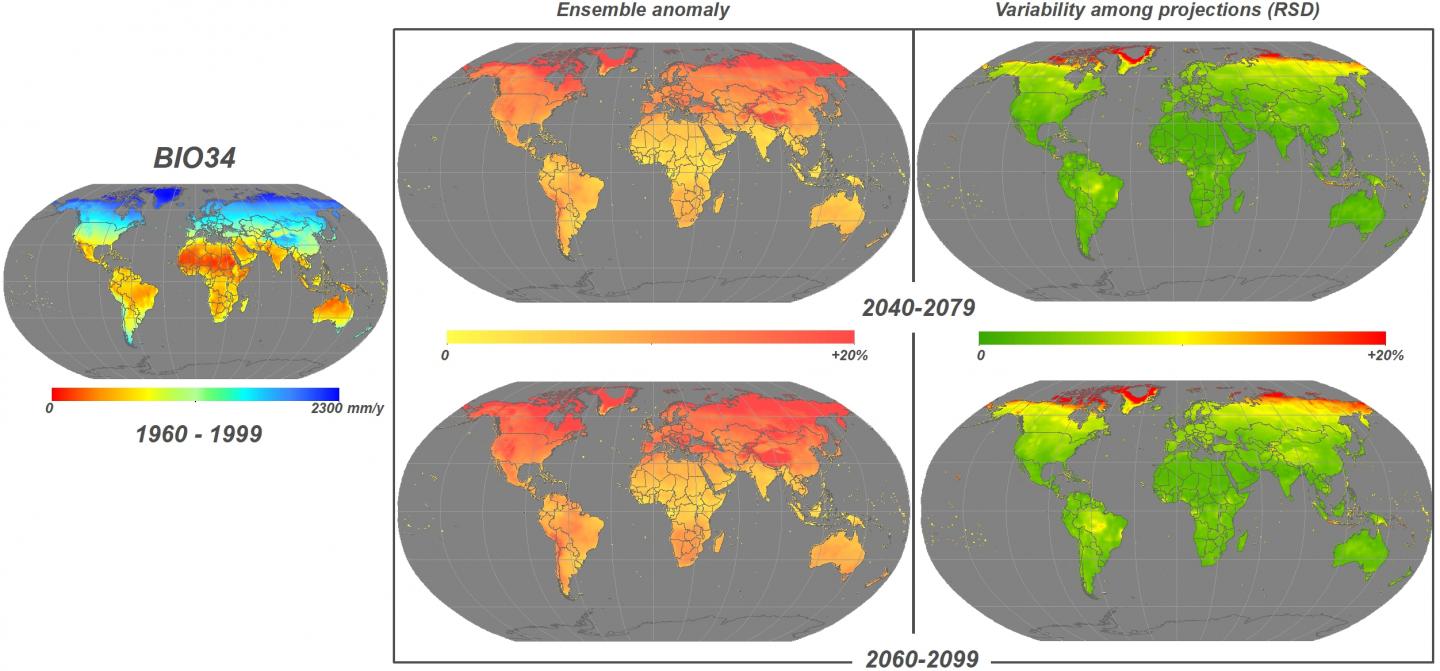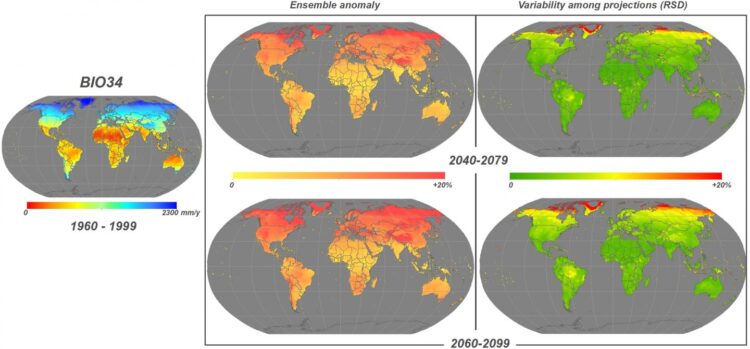
Credit: Noce, S., Caporaso, L. & Santini, M. A new global dataset of bioclimatic indicators. Sci Data 7, 398 (2020). https://doi.org/10.1038/s41597-020-00726-5
Creative Commons License: CC BY…
Climate change impacts, affecting primarily ecosystems’ functions and consequently human sectors, have become a crucial topic. Observed and expected variations in climate conditions can in fact undermine the ecosystems’ ecological equilibrium: average climate patterns, mainly represented by intra-annual (monthly to seasonal) temperature and precipitation cycle, directly influence the distribution, abundance and interactions of biological species.
During the long history of scientific research on the relationships between climate and Earth’s communities, numerous meteorological variables and/or derived indices have been formulated, calculated and applied to explain the geographic distribution of natural populations along climate gradients, characterized by intra-annual patterns of temperature and precipitation. Such variables and indices are also known as bioclimatic indicators (BioClimInd). They mainly result from primary – observed or modelled – climate fields (e.g. minimum, maximum and mean temperature, precipitation amount) and contribute to delineate the bioclimatic “envelope” for species in terms of favourable environmental conditions, also referred to as “suitability.
A study led by the CMCC Foundation and recently published on the Nature Journal Scientific Data released a new global and free access dataset of bioclimatic indicators at 0.5° by 0.5° spatial resolution (ca. 50 km at the equator) for historical and future conditions. “Our target was to widen the availability of bioclimatic information by an ensemble of bioclimatic indicators valuable both for historical and future robust climate change impacts’ assessments”, explains Sergio Noce, CMCC scientist and lead author of the study. His research at CMCC focuses on the analysis of the potential impacts of climate change on spatial distribution of forest species. “We’re thinking about a wide range of research fields such as wildlife ecology, natural resources’ conservation and management, botanic, forestry and many other fields involving biogeography. More in general, our data could be useful for all studies using species distribution modelling. Considering its spatial resolution, this dataset will be especially suitable for studies at continental – global scale, for example, to study regions such as the Mediterranean or the Russian territory; even before releasing the dataset, our team published a work on the impacts of global warming on Russian forests from a biogeographical perspective using these bioclimatic indicators”.
What is meant by biogeography and why bioclimatic indicators are so important? As he explained in his Nature Behind the paper article, “Biogeography studies the distribution of species and ecosystems in a geographic space and the relationships between these communities and, among others, the climatic conditions: bioclimatic indicators summarize these conditions. Changes in species distribution has always occurred; there are many examples of animal or plant species that ‘migrated’ towards more suitable environmental and climatic conditions in the past. To make an example, starting from the end of the most recent glaciation (approx 11-12,000 years B.P.) the European hazel were only in some glacial refugia in southern Europe; as climate was getting warmer, hazel started to migrate north and spread in all the European continent. Climate change accelerated this processes and today understanding and being able to forecast future climate envelopes, that is understanding how species distribution and occurrence will change in the future, is becoming always more important.”
The new dataset, called CMCC-BioClimInd, will contribute to achieve this goal while providing a set of 35 bioclimatic indices calculated both for a 40-years historical interval (1960-1999) and for two future time horizons (mid-term 2040-2079 and long-term 2060-2099) from, respectively, post-processing of climate reanalysis and an ensemble of 11 Coupled Model Intercomparison Project Phase 5 (CMIP5) bias corrected climate simulations.
Therefore the new CMCC dataset of bioclimatic indicators will be useful to a broad community of researchers aiming at reproducing and modelling, respectively, current and future habitats’ ranges by mean of a Species Distribution Modelling (SDM) approach, where large amount of high quality and up-to-date environmental (especially climate) data is required.
“On the one hand”, Noce concludes, “the exploitation of indicators instead of just raw climate variables enables easier inferring of relationships between the studied topic (species occurrence, resources availability etc.) and the climate regime to support decision for complex systems; on the other hand, using the ensemble allows considering the variability across simulations due to the different models’ physics and the uncertain future development pathways.”
The work is ongoing and in the near future, CMCC researchers wish to keep CMCC-BioClimInd up-to-date adding more climate simulations and/or further model outputs.
The data of individual indicators are publicly available for download in the commonly used Network Common Data Form 4 (NetCDF4) format in CMCC Data Delivery System (CMCC DDS) just released online, a unique, consistent and seamless access point for all data produced and used by CMCC.
###
For further information, read the full version of the paper:
Noce, S., Caporaso, L. & Santini, M. A new global dataset of bioclimatic indicators. Sci Data 7, 398 (2020). https:/
Media Contact
Mauro Buonocore
[email protected]
Original Source
https:/
Related Journal Article
http://dx.





